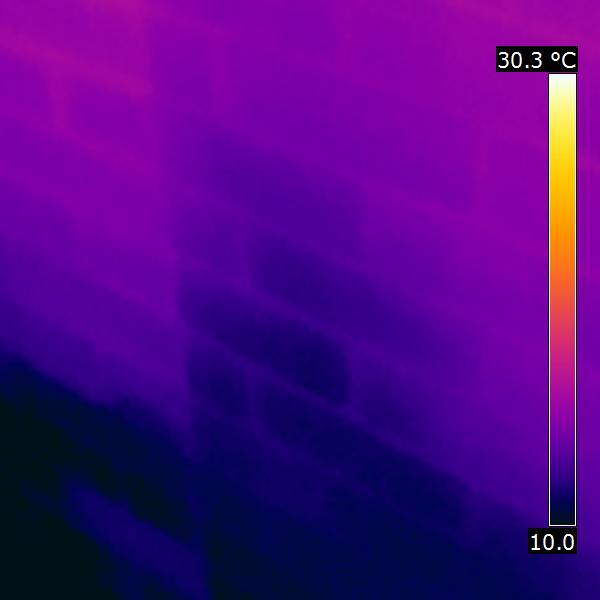I've been carrying out a thermal survery of my home, and identified an area of damp in an external wall. On closer inspection (the old loo roll against the brickwork test) it is indeed damp.
There are actually two walls there, the one to the left is original 1980's and the one to the right is from an extension completed in 2008. The original wall has an open 50mm cavity, but the extension has 50mm of PIR insulation against the inner block skin and then a cavity that I think is about 50mm again. The PIR boards were foil laminated, but were not taped (there is a vapour barrier immediately behind the inner palsterboard, which is attached to battens). The brick work from each 'building' is tied together with wall starters, which start 1/2 course above the external DPC. (DPC is shown as black in the photo). There is a vertical DPC run the height of the building between the wall starter track and the existing wall, which is then bolted through. There is no plumbing or guttering near to this area.
The damp is clearly only affecting the new wall, but I am unsure why. The wall is also south-east facing, and gets good sun light, and there is never standing water on the bottom of the wall. Given the shape of the damp patch it appears to me that it is rising up? Or could it be rain penetrating the brick work?
I would be gratefull if anyone with more experience of this sort of thing could please share any thoughts. Thanks.
There are actually two walls there, the one to the left is original 1980's and the one to the right is from an extension completed in 2008. The original wall has an open 50mm cavity, but the extension has 50mm of PIR insulation against the inner block skin and then a cavity that I think is about 50mm again. The PIR boards were foil laminated, but were not taped (there is a vapour barrier immediately behind the inner palsterboard, which is attached to battens). The brick work from each 'building' is tied together with wall starters, which start 1/2 course above the external DPC. (DPC is shown as black in the photo). There is a vertical DPC run the height of the building between the wall starter track and the existing wall, which is then bolted through. There is no plumbing or guttering near to this area.
The damp is clearly only affecting the new wall, but I am unsure why. The wall is also south-east facing, and gets good sun light, and there is never standing water on the bottom of the wall. Given the shape of the damp patch it appears to me that it is rising up? Or could it be rain penetrating the brick work?
I would be gratefull if anyone with more experience of this sort of thing could please share any thoughts. Thanks.



